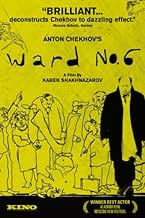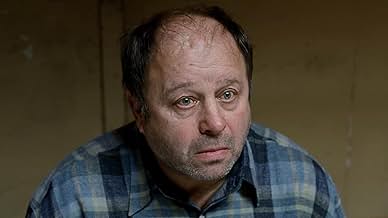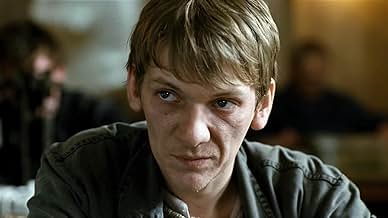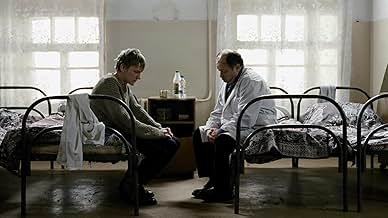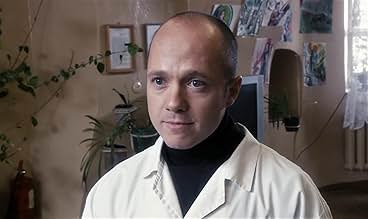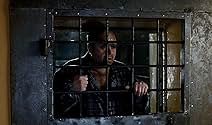Ajouter une intrigue dans votre langueSimultaneously nihilistic and heartening, Ward No. 6 is based on a story by Chekov, in which a psychiatric doctor becomes a patient in his own asylum. Updated to contemporary Russia, the fil... Tout lireSimultaneously nihilistic and heartening, Ward No. 6 is based on a story by Chekov, in which a psychiatric doctor becomes a patient in his own asylum. Updated to contemporary Russia, the film is a cocktail of anxieties and riddles, showcasing how easy it is to become what we fear... Tout lireSimultaneously nihilistic and heartening, Ward No. 6 is based on a story by Chekov, in which a psychiatric doctor becomes a patient in his own asylum. Updated to contemporary Russia, the film is a cocktail of anxieties and riddles, showcasing how easy it is to become what we fear most.
- Réalisation
- Scénario
- Casting principal
- Récompenses
- 4 victoires et 7 nominations au total
Avis à la une
Shakhnazarov seems to be a dislocated guy. Someone born within the values of the great soviet school, but who lost that context early in his career. Today he makes disembodied soviet films. And also he doesn't really represent any of the two major soviet contributions to cinema (leaded by Eisenstein and Tarkovsky, respectively). For this, i don't think i'll ever watch one of his films that does more than merely amuse me in how clever were the intentions behind it.
In this case, what he wanted to do was not novel, but it's not very well done either. He starts the film presenting us with a series of interviews to real ill people from a real mental institution. Than he delivers a fiction, with fiction characters modelled after the real ill people, and acted in the same physical place, the hospital. This is actually a very clever idea. The interviews place us in the world of the mental cases, so we need no more establishing of the world of the film. So, we get fully inside the film and that's something rarely done in such a clear effective way. The problem is that nothing else is worth your time. there is a very literature driven approach to the dialog writing, and that kills the film, which is also not carried well enough by the performances. Dialogs or acting are the things that can carry such a film. Non exists with quality here.
The closing scene is as clever as the initial one. Real patients meet fictitious ones, and they dance, with mixed pairs. Documented reality merges with fictionalized reality. The entry, and this last sequence almost redeem the lack of anything else in the film.
My opinion: 2/5
http://www.7eyes.wordpress.com
This simple story raises complex questions in our mind. What is insanity? Who defines it? The director narrates Chekov's story in a semi documentary fashion. It doesn't work too well and leaves us rather indifferent to Doctor Ragin's predicament. But I think this form of narration serves the purpose of setting Chekov's story in the contemporary context. The haunting New Year's eve dance sequence is comical yet so chilling! How easily does the State machinery makes its citizens fall in line. What if the State is a lunatic asylum? Thought provoking question for citizens who live under dictatorial regimes!
The film ends with a very intriguing sequence in which a woman who lived next door to Doctor Ragin is being interviewed. Her younger child cannot suppress her laughter and the camera lingers long over her face and that of her sister. Is it laughter of innocence or mischief? The viewer has to make his own judgement.
There was nothing intellectually or artistically stimulating about watching these poor people... and there was nothing intelligent about the story superimposed on them at least in the confusing way this film portrays it.
Apparently in the original short story (By Chekhov) a Doctor finds the most interesting person in the backwater where the psychiatric instution is located is one of the paranoid schizophrenics. That is believable. In the original story this Doctor is tricked into being admitted into the hospital...also believable but none of this comes out in this movie! In the movie this Doctors best friend runs a store or so it seems. And then this Doctor is admitted and has a stroke. None of it is explained...
I also felt sorry for the patients being filmed. The ending with kids laughing was supposed to be deep in some way and like the rest of this movie is nothing more than meaningless garbage thinking it is deep or artful.
Also cheaply filmed and very erratic camera work.
DO NOT RECOMMEND
The movie might seem slow to some viewers. It's like that for a reason. It gives the patient time to explain his philosophy to the doctor. The movie poses the question of which people can be considered insane in a rotten-to-the-core society (much like how "A Clockwork Orange" does). Most of the movie takes place indoors, emphasizing the feeling of imprisonment.
I don't know that I would call it a masterpiece, but it's worth seeing. It not only addresses the issue of insanity, but also shows the horrible conditions in the mental institutions. I'd say that it was the right choice for Russia's submission to the Academy Awards that year.
Le saviez-vous
- AnecdotesRussia's official submission to the Best Foreign Language Film Category of the 82th Annual Academy Awards (2010).
- Citations
[first lines]
Vladimir Kozlov: Vladimir Vladimirovich Kozlov, born in 1979, on August 15.
Interviewer: For how many years have you lived here?
Vladimir Kozlov: This is... the fifth year.
Interviewer: Where did you live before you came to this nursing home?
- ConnexionsFeatured in 8½ Kinoklub Dyskusiynyi (2016)
- Bandes originalesAkapulko
Music by Igor Krutoy
Lyrics by Viktor Pelenyagre
Performed by Laima Vaikule
Played at the New Year party
Meilleurs choix
Détails
- Date de sortie
- Pays d’origine
- Sites officiels
- Langue
- Aussi connu sous le nom de
- Salle n°6 - Tchekhov
- Lieux de tournage
- Dmitrovsky rayon, Moskovskaya oblast, Russie(mental health nursing home)
- Société de production
- Voir plus de crédits d'entreprise sur IMDbPro
Box-office
- Montant brut mondial
- 115 095 $US
- Durée1 heure 23 minutes
- Couleur
Contribuer à cette page


